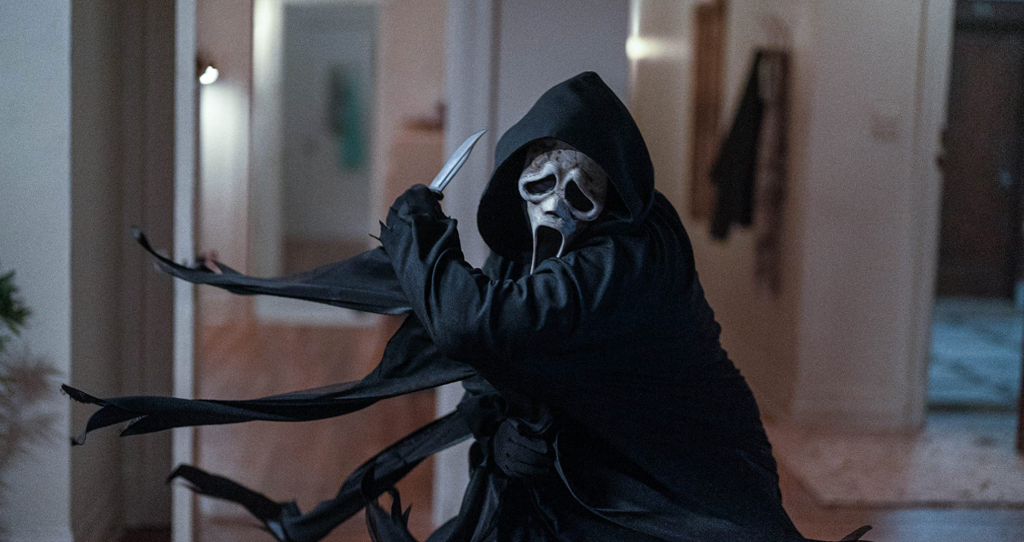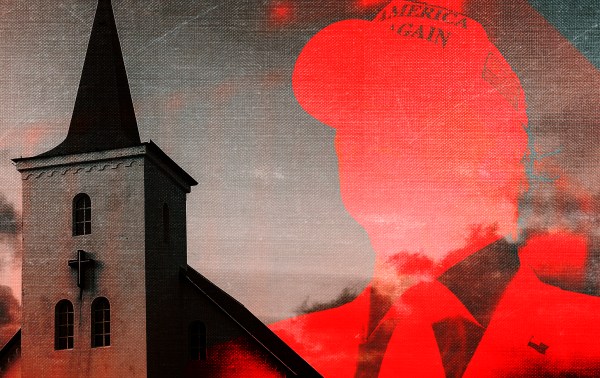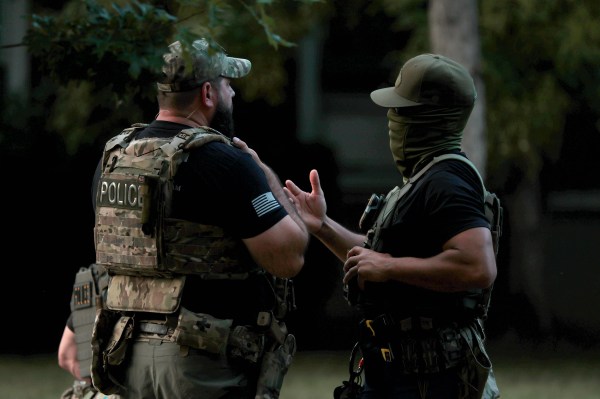You’ve seen it before: A horror movie that begins with the camera firmly planted on an attractive blonde who suddenly receives a phone call. The voice on the other end is seductive and mysterious; gradually, it lures her into a trap. There’s a flash of steel, an eruption of blood, then a screech of horns or strings as a title card appears.
But Scream VI, initially at least, is smart enough to subvert such a conventional approach. Its opening sequence slices the original film’s introduction to pieces, rearranging them into something strikingly fresh. The familiar female victim is present, but only momentarily. What replaces her should be seen rather than spoiled, and it’s guaranteed to hook even the most jaded horror connoisseur. The opening skirts predictability, revealing itself delicately. When the final twist arrives, the only appropriate response is a mixture of surprise and delight at the inventive viciousness on display.
It’s the most exciting opening to a Scream film since the original, rivaled only by Scream 4’s reality-bending prelude. And the ingenuity it demonstrates on behalf of directors Matt Bettinelli-Olpin and Tyler Gillett is particularly shocking considering the near total absence of good ideas that defined their previous entry in the series. Last year’s Scream (irritatingly branded without a “V”) was a disastrous melange of vapid satire, colorless characters, and nauseating nostalgic pandering. Its script, unsullied by such qualities as coherence or wit, was so obsessed with appearing self-referential that it failed to create any actual tension, or to attempt anything even moderately adventurous.
When Scream VI was announced, it seemed the duo intended to degrade the franchise even further. A sixth film, released little more than a year after the last and set in New York City—the idea evoked Friday the 13th Part VIII: Jason Takes Manhattan, a desperate effort to sustain a property that had already become its own best parody. But in practice, the shift in setting is refreshing rather than gimmicky. By embracing an environment so far removed from the woody sprawl of Northern California, Bettinelli-Olpin and Gillett are able to construct unique set pieces that offer more thrills than the usual chases through suburban houses.
Besides its messy climax, the film’s action sequences are varied, intense, and regularly filled with gore. On the subway, Ghostface exploits flickering lights and ubiquitous Halloween costumes to stalk a victim through a crowded train; the suspense builds at an achingly steady pace as the camera lingers on various suspects. In a student dorm, things are more aggressive; Ghostface breaks down doors and savagely hacks through obstacles, intent on reaching his prey. Bettinelli-Olpin and Gillett’s ruthless depiction of the killer is exhilarating, and often genuinely threatening. His dialogue, penned by screenwriters James Vanderbilt and Guy Busick, is menacing and sharp, free from much of the juvenile coarseness that pervaded the previous installment.
As gripping as the set pieces may be, there’s a certain silliness beneath all of them. When the script demands it, Ghostface can seemingly teleport between buildings and avoid bullets with preternatural speed. The characters commonly survive mortal stab wounds with only a few scratches to show for it, and they’re often completely oblivious even by the standards of New Yorkers. (Whenever the killer strikes in an apartment, his victims are unable to hear him butchering their friends and talking loudly on the phone from within adjoining rooms.) It doesn’t help that the film was shot in Montreal, which adds a distractingly false quality to the action. The streets are wide, there’s a long alleyway on every block, and the skyscrapers look like shoeboxes. Though it’s relieving that the directors didn’t feel the need to gratuitously insert a landmark into every scene, the illusion they’ve conjured is unconvincing. Only the subway sequence and a scene involving a ladder put the Big Apple’s distinctive geography to effective use.
But despite their sporadically brain-dead tendencies, the protagonists are infinitely more likable than before. We focus on Samantha and Tara Carpenter (Melissa Barrera and Jenna Ortega), who’ve moved to New York for college after surviving Ghostface’s rampage in the previous film. Joining them are high school friends Chad and Mindy Meeks-Martin (Mason Gooding and Jasmine Savoy Brown) alongside a handful of new faces, most of whom are disposable additions inserted to inflate the body count. Last time, Barrera, Ortega, and Gooding had little to work with besides forced one-liners and bland exposition, leading to a uniformly dead-eyed set of performances. Here, their characters are vastly more developed, and though a few lines still feel like material from a failed sitcom pilot, some inspired jokes are peppered throughout. The interplay between the three is usually charming, and when Barrera and Ortega kick into full scream queen mode, they’re positively magnetic to watch.
Regrettably, the same can’t be said for Savoy Brown, who spends the movie spouting obnoxious meta-commentary about “sequels to requels” and the horror formula. She tries her best, but Vanderbilt and Busick offer her no insightful material to work with; their references to contemporary trends and franchises are shallow and listless attempts at providing the satirical content fans of the series have come to expect. While the returning characters are more rounded, it’s impossible to find any personality at all in newcomers Ethan Landry (Jack Champion)—a student at the college—and Danny Brackett (Josh Segarra)—a love interest for Sam who apparently stole her heart despite having the emotional complexity of a brick. Courtney Cox returns as Gale Weathers. Delightfully sarcastic as ever, she could nevertheless be removed from the plot without consequence. (Amusingly, she also lives in a lavish penthouse that would be out of budget for a fund manager, never mind a true crime novelist.)
These imperfections can’t prevent Scream VI from being thoroughly entertaining in its first two acts. But as the film approaches its denouement, it slowly deteriorates, just as its protagonists gradually begin to act in increasingly idiotic ways. At first, Bettinelli-Olpin and Gillett appear intent on bending the franchise’s rigid rules. Beyond the subversive set pieces, Ghostface spends remarkably little time on the phone, and he’s seemingly animated by pure bloodlust rather than an obsession with horror cinema. (“Who gives a f—- about movies?” he growls at one victim with captivating malice.) And yet they can’t deliver on their promise.
When the climax—which occurs in a drab, abandoned theater rather than somewhere novel—finally arrives, the directors bend to the oppressive weight of Scream’s traditions. Ghostface’s identity is risible, his motivations squander the potential of his earlier characterization, and the reveal gives rise to a profusion of plot holes. By succumbing to the temptation to mirror previous films, Bettinelli-Olpin and Gillett leave themselves with no plausible options for a face behind the mask.
Scream VI is a tragic case of wasted potential. Like its predecessor, it lacks the courage to take any major risks, or to embrace the unexpected and push beyond the series’ conventions. There’s much to enjoy here, but the many detached highlights can’t coalesce into a satisfying whole. In the film’s second half, nostalgia overwhelms its plot, as Bettinelli-Olpin and Gillett’s fixation on the franchise’s history leads them to unleash a deluge of self-references, in-jokes, and cloying tributes to past movies. It’s all hugely tedious, and the lack of confidence it suggests in the directors to pursue their own vision is especially frustrating considering how successful the film can be at its most innovative. Scream VI proves that there’s potential for a truly impressive new entry in the series to be made, but that will only happen if it can break free from its overbearing ancestry.






Please note that we at The Dispatch hold ourselves, our work, and our commenters to a higher standard than other places on the internet. We welcome comments that foster genuine debate or discussion—including comments critical of us or our work—but responses that include ad hominem attacks on fellow Dispatch members or are intended to stoke fear and anger may be moderated.
With your membership, you only have the ability to comment on The Morning Dispatch articles. Consider upgrading to join the conversation everywhere.